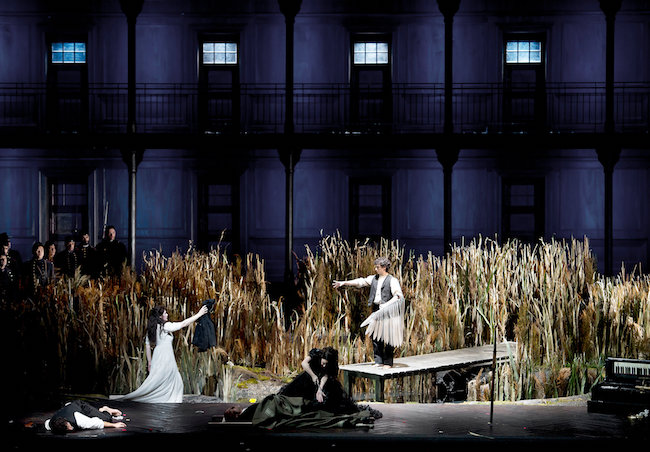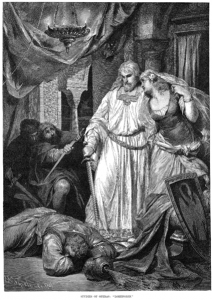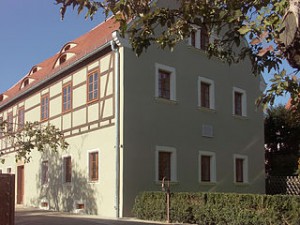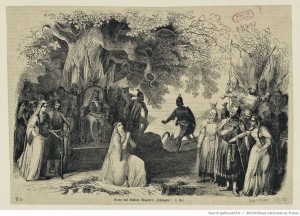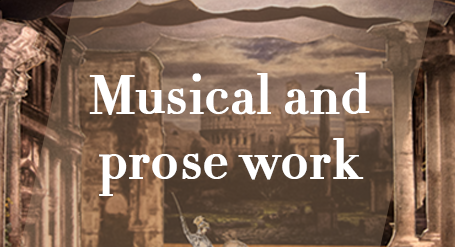
The musical work of Richard Wagner is composed of operas or “musical dramas” ranging from “Fairies” (Die Feen) to “Parsifal”. A detailed presentation of each of these major works is associated here with a set of thematic articles, placing them not only in the context of his personal life but also in his social, economic and cultural context. This section also includes all the musical works (excluding opera) and his literary work.
Lohengrin, WWV75
Lohengrin, WWV75
In short
Lohengrin (WWV 75) is the sixth of Richard Wagner’s operas and the third of the composer’s operas created during his “mature” phase. Composed between 1845 and 1848, Lohengrin is consistent with the operas composed for the Opera of the Royal Court of Saxony where Wagner, who then assumed the position of choirmaster, had finally reached the status of “respectable” composer after the resounding success of the production of Rienzi, the last of the Tribunes (20 October, 1842), and the mixed success of The Flying Dutchman (Der Fliegende Holländer) (2 January, 1843) and Tannhäuser (19 October, 1845).
It was during his Parisian stay from 1839 to 1842 and when he discovered the ancient Germanic legends that gave him material to compose his Tannhäuser that Wagner also got acquainted with the legend of the Knight of the Swan. The essential inspiration for the composer came from Wolfram von Eschenbach’s Parzival (a 13th century poem that associates the chanson de geste from the Epic of The Holy Grail to the Knight of the Swan) as well as the German legends that the Grimm brothers had published between 1816 and 1818. In the different versions of the legend related to the character of Lohengrin are preponderant the theme of the Knight’s mysterious origins, the prohibition against him revealing his name as well as the pain that his love feels for not being able to ask the fateful question.
As always more concerned with the dramatic scope of the work than with fidelity to his sources, Wagner introduced in it the paraphrase of the misunderstood poet of the world of humans who could only fully live its glory and success when withdrawn from the world…
Still influenced by the classical opera tradition in the casting of roles, particularly with regards to the opposition of the innocent couple to the treacherous couple, Richard Wagner added to his drama two characters, Ortrud and Telramund, whom he devoted as evil counterparts of the characters of light, purity and innocence that are Lohengrin and Elsa. But even more than a character with purpose and evil power, Wagner conceived the key figure of Ortrud as “a reactionary, and that in the most outrageous sense of the word” (letter to Franz Liszt, 30 January, 1852). Wagner thus went beyond the archetype of the duo formed by the soprano/tenor heroes to that of the mezzo-soprano/baritone, endowing his characters with a more complex characterization.
Richard Wagner put on paper the first sketches of his drama conceived as a “grand romantic opera in three acts” starting from the summer of 1845, during his stay in Marienbad with his wife Minna (at the house called “To the clover leaf “). From the end of the summer, the overall plot of the libretto had been sketched; the writing of the poem in verse took him just a few months and he embarked on the composition of the music in the spring of 1846: this one – largely composed during a summer stay in 1846 in Saxon Switzerland, in Pirna Graupa, in a house nicknamed from the Lohengrinshaus which adjoined Hans von Bülow’s birthplace – took him two years. The entire score was completed in April 1848. The prelude, lasting about ten minutes, that presents and develops the Lohengrin theme mixed with that of the Grail, was composed last.
With Lohengrin, Wagner resolutely freed himself in his composition from the classical opera style. Through this dreamlike score, the composer developed for the first time his concept of continuous melody and recurrent use of leitmotifs. It is through their use that the composer built the melodic framework of his opera, placed sometimes in a major tone to expose the brilliant themes of the victory of the love and glory of the hero or in a minor tone to illustrate the doubt or the dark intentions of the treacherous couple. Carrying the work on musical writing to a degree of complexity that he had not explored up until that point, Wagner even went so far as to compose certain pages which almost announced the musical language of The Ring of the Nibelung (especially in the first scene which opens the second act and which features the dialogue between Ortrud and Telramund).
Although Lohengrin was originally intended to be performed on the stage of the Semperoper in Dresden, where his previous masterpieces were born, popular uprisings erupted throughout Europe, calling in particular for the prohibition of censorship and freedom of the press, put a brutal stop to this project. Indeed, Wagner was not satisfied with his duties as composer and musician. Having submitted his resignation as choirmaster to the Court, he befriended insurgents such as August Roeckel and Mikhail Bakunin, and took the side of the rebelling people. Once the insurrection was repressed by the royal forces, the composer had to flee and go into exile for many years … without having seen the birth of his masterpiece.
The production of Lohengrin took place, without the attendance of its composer banned from entering Germany, on 28 August, 1850 at the Grand Ducal Theatre in Weimar, during the parties organized in commemoration of the centennial of the death of Goethe, under the musical direction of Franz Liszt. Wagner only attended its performance eleven years later, during a production at the Vienna Opera on 15 May, 1861. Wagner’s emblematic work par excellence, exalting romanticism, Lohengrin is now one of the composer’s most performed operas.
NC
If you wish to share further information about this article, please feel free to contact us !
